
August 2022
Unpayable Debt, Food Shortages, Runaway Fuel Prices Hit Dozens of Countries
Sri Lanka Economy Collapses,
Masses Rise Up, President Flees
But Capitalist Crisis Remains
Forge a Trotskyist Party on a Transitional Program for Socialist Revolution
For the Right of Tamil Self-Determination! For a Socialist Federation of South Asia!
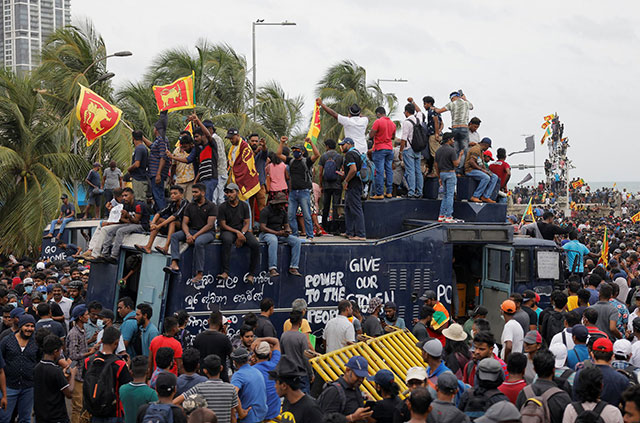
Protesters swarm police tear gas truck after storming presidential compound in Sri Lanka capital of Colombo, July 9, demanding resignation of President Gotabaya Rajapaksa. Three days later he fled the country. (Photo: Dinuka Liyanawatte / Reuters)
SYDNEY, Australia – Since early this year, Sri Lanka has been rocked by the most severe economic, social and political crisis it has experienced since independence from Britain in 1948. After several years of rising income from a flourishing tourism industry, the bottom dropped out after the Easter 2019 terrorist attack on churches and hotels in the capital, Colombo, followed by the COVID-19 pandemic that all but wiped out this main revenue earner. By March 2022, the island nation off the southern tip of India had run out of foreign exchange, while saddled with US$51 billion in foreign debt. Now prices for vital food and fuel imports have shot up due to sanctions imposed on Russia over its war with Ukraine, instigated by the United States and its NATO (North Atlantic Treaty Organisation) imperialist allies, and the U.S. Federal Reserve is ratcheting up interest rates. Result: Sri Lanka is broke.
As the country of 22 million people is unable to purchase basic goods, daily life for the masses has become unbearable. People line up for hours and days for petrol (gasoline), cooking gas, milk powder, food and medicines, often only to be told none is available. Power outages, with blackouts of 12-15 hours or more per day, are common. Meanwhile, the Electricity Board raised rates by 75%. Shortages have driven the annual inflation rate to over 40%, while food prices are up by more than 80%. In mid-April, payment of foreign debt was suspended and in May Sri Lanka formally defaulted. With petrol stations locked and people forced to cut back on meals, mass demonstrations multiplied, protest camps sprung up and general strikes were held on 28 April and 6 May calling for the resignation of the government.
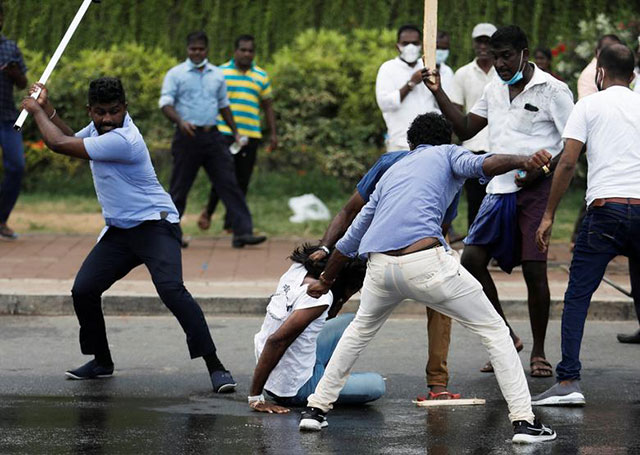
Government supporters brought in by Prime Minister Mahinda beat protesters, May 9. Amid uproar, he resigned. (Photo: Dinuka Liyanawatte / Reuters)
Then on 9 May, now known as “Black Monday,” Prime Minister Mahinda Rajapaksa bussed in hundreds of government supporters from across the island, who met at his official residence and then stormed the protest camp at Galle Face, on Colombo’s seafront, burning their tents. Over 200 were injured and at least eight killed. Furious protesters lashed out by torching the homes of leading politicians of the ruling Sri Lanka People’s Front (SLPP, from its initials in Sinhala) while thousands surrounded the home of the prime minister, who resigned and was rescued by a Lankan air force helicopter. Protesters then turned to the president, Gotabaya Rajapaksa, Mahinda’s younger brother, whose resignation they had also been demanding. The government mobilised the military and issued “shoot-to-kill” orders.
With its economy in shambles, the mass of the population living hand-to-mouth, day to day, Sri Lanka has been in an almost continuous upheaval for almost five months now. The popular response was to blame the calamity on the boundless corruption of the Rajapaksa “dynasty,” which has dominated the island with its hard-fisted rule for most of the last two decades. The SLPP government, elected in 2019, had four Rajapaksa brothers in top posts, including finance minister Basil, until he resigned under fire in April. “This is our country, not your ATM,” read one protest sign. After Mahinda quit as prime minister, the protesters focused on calls for Gotabaya’s ouster as well. Their encampment, originally named “Occupy Galle Face” (after the 2011-12 Occupy Wall Street movement), was renamed Gota Go Gama (village, in Sinhalese).
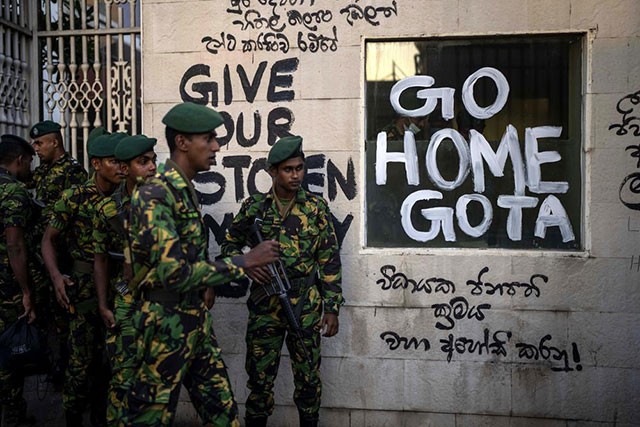
Army soldiers patrol near Sri Lanka’s presidential compound on on July 12, three days after protesters seized it.
(Photo: Rafiq Maqbool / AP)
Two months after Black Monday, as another attempted police crackdown backfired, on 9 July thousands swarmed the President’s House as well as that of the new prime minister, Ranil Wickremesinghe. For the next few days, protesters lounged around the residences, took a dip in the pool, picnicked in the formal garden and scrawled “Go Home Gota” on the walls. And then suddenly the Rajapaksas were gone, as Gotabaya and his wife fled aboard a military plane to the Maldives, on to Singapore and to Thailand where he is awaiting a “green card” to return to the United States.1 Wickremesinghe offered to resign as prime minister (a position he has held six times since 1993), but then was named acting president and on 21 July was duly designated president by parliament, still dominated by the Rajapaksas’ SLPP.
While the venal and nepotistic Rajapaksas are out, their hand-picked successor has continued their policies of vicious repression and brutal anti-working-class austerity. The day after Wickremesinghe took office, in the pre-dawn hours of July 23, some 1,000 heavily armed military and police security forces stormed the protesters’ encampment outside the presidential compound. He declared a state of emergency under extraordinary powers of the “executive presidency,” giving him broad, unilateral authority over the nation’s security forces. Over 100 activists, journalists, student and trade-union leaders have been arrested, including one Joseph Stalin, the secretary (top leader) of the Sri Lanka Teachers Union. Meanwhile, the government is negotiating with the International Monetary Fund (IMF) for a loan, its 17th (!) since 1965.
Protesters have taken aim at the theft (“give our stolen money back”) and colossal economic mismanagement (slashing taxes, cutting off fertilizer imports) of the Rajapaksa regime. More fundamentally, the Lanka crisis is an acute manifestation of imperialist looting of semi-colonial countries, augmented by the global COVID pandemic and the backfiring Western sanctions against Russia. Social explosions like that consuming Sri Lanka could erupt in dozens of countries around the world facing bankruptcy in a decaying capitalist system amid a looming world recession and skyrocketing inflation. An IMF “bailout” would certainly require privatisations (the Electricity Board and Petroleum Corporation are already being “restructured” in anticipation of that), slashing food and fuel subsidies and further immiserating the poor.
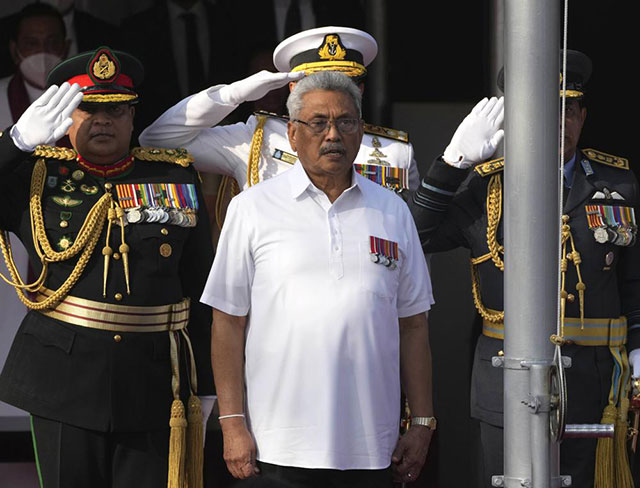
Sri Lankan president Gotabaya Rajapaksa, shown here at independence day celebration, 4 February 2022, won office as the mailed fist of Sinhalese chauvinism. He was head of the Lanka army in 2005-09 when it slaughtered tens of thousands of Tamils. (Photo: Eranga Jayawardena / AP)
Marchers in Colombo did not limit themselves to calling for an end to the endlessly corrupt Rajapaksa clique, but extended their demands to all the politicians who have ruled and ruined this island nation, which not long ago had the highest living standards in the region. Demands of the protest movement – the aragalaya (struggle) – for “Go home Gota!” were soon joined with “Go home 225!” referring to all members of the parliament. What they got instead was a deeply unpopular president “elected” by the discredited legislature. Wickremesinghe is the leader of the arch-conservative United National Party (UNP), which has governed Sri Lanka for 38 out of the 74 years of its independence. So as protesters now chant “Go home Ranil!” the system remains, and with it the mass impoverishment that is fundamental to semi-colonial capitalism.
On an island marked since independence by sharp divisions between a predominantly Buddhist Sinhalese majority and a mostly Hindu Tamil minority, the Rajapaksas came to office, twice, as the embodiment of harsh military suppression of ethnic minorities. Mahinda Rajapaksa was elected in 2005 (against Wickremesinghe) demanding a hard line to put an end to the civil war that had lasted since 1983. In that year, the Liberation Tigers of Tamil Eelam (LTTE) had launched guerrilla attacks in response to pogroms and massacres by Sinhalese mobs, instigated by the UNP, against Tamils in Colombo and elsewhere. With Mahinda as president, Gotabaya Rajapaksa was the head of the armed forces that slaughtered some 40,000 Tamils in the final period of the genocidal war that killed an estimated 100,000 and disappeared another 20,000.
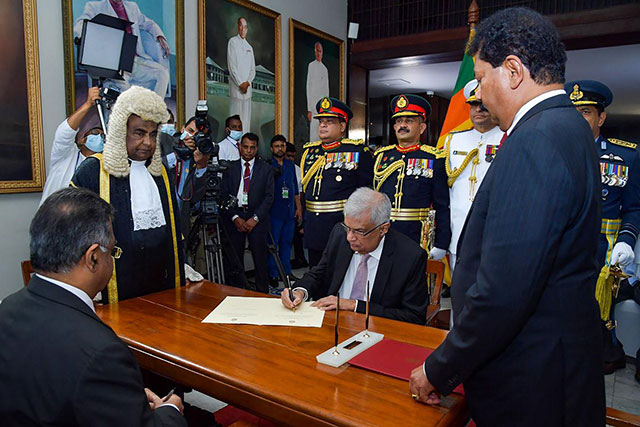
Ranil Wickremesinghe sworn in as president of Sri Lanka, “elected” by discredited parliament, July 21. The next day he unleashed a brutal attack on protesters camped outside the presidential compound. (Photo: Ishara Kodikara / AFP)
The Rajapaksas’ second election victory, in 2019, was based on their vow to crack down on Sri Lanka’s Muslims, considered responsible for the Islamist bombings. The SLPP represents the iron fist of Sinhalese Buddhist nationalism, which still dominates the major bourgeois parties, including the so-called “opposition.” The mass anti-government mobilisations themselves have not been marked by the overt communal divisions between Sinhalese and Tamils that Sri Lanka’s rulers have repeatedly relied on to divide and divert the struggles of the oppressed. But that may be due in part to the fact that many Tamils in the northern and eastern provinces hung back, some figuring that it serves the Sinhalese right for massively voting for the SLPP. Also reportedly largely absent from the protests, at least early on, are the Muslim minority, which bore the brunt of the Rajapaksas’ latest campaign of ethno-communalist repression.
Now Wickremesinghe is using his predecessors’ favoured tool for terrorizing opponents, the Prevention of Terrorism Act, enacted by UNP president J.R. Jayawardene in 1978. Under this draconian legislation, those accused of “unlawful” activity can be held for a year without any possibility of judicial intervention, while actions such as putting up posters can be punishable by death. This “anti-terror” law is now being used to quash opposition to the anti-worker policies of the new government in exchange for a short-term IMF bridge loan, reportedly of a measly US$3 billion, which won’t even cover interest on existing loans. Projected cuts may include slashing tens of thousands and even hundreds of thousands of public sector jobs, in addition to the already decreed wage freeze for government workers while prices of essentials are skyrocketing.
Class-conscious workers should demand the abolition of the Prevention of Terror Act and immediate release of all those held under it.
Whither Sri Lanka? Toward Socialist Revolution or Authoritarian Capitalist Rule
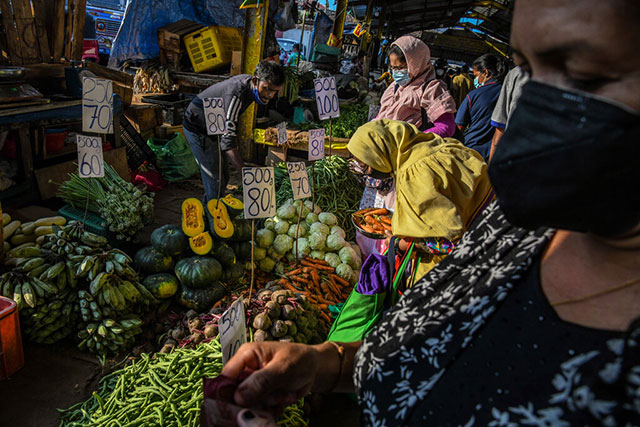
A vegetrable market in Colombo in March. Food prices have soared by 80%, forcing many into desperate poverty, hunger and, in some areas, starvation. (Photo: Atul Loke for The New York Times)
Not only the hard-hit working people of Sri Lanka, but the imperialist rulers as well are concerned about the outcome of the present struggle – for opposite reasons. Early on, the British Economist (16 May) worried: “Sri Lanka’s default could be the first of many.” If one country after another stopped paying its tribute to the imperialist creditors and paymasters (i.e., the foreign debt), the effect on the tottering house of cards of world finance capital could be devastating. The Lehman Brothers default that set off the 2008 Wall Street crash and a decade-long depression could pale in comparison. A month later (14 May), this house organ of the London global bankers headlined: “Sri Lanka has no money and no government. What now?”
In the short term, it is unclear if the crackdown will stem or further inflame the widespread protests which have mobilised hundreds of thousands of Lanka’s angry and desperate masses. The government is widely seen as illegitimate, and is having difficulty finding parties willing to form a new majority coalition. Yet the upsurge has fallen back and lacks direction or mass worker participation. The back-to-back “general strikes” in April-May, while quite large, were only one-day affairs and focused on ousting the Rajapaksas, which has now happened, to little effect. The first organised protest since Wickremesinghe took over was held on 9 August, called by trade unions and human rights groups demanding new elections and an end to arrests, but drew only a few hundred participants.
Various accounts of the Lankan aragalaya note the middle-class character of the leadership – “civic” and human rights groups, lawyers, student/youth organizations, etc – with the working class largely absent. In many respects it resembles the large protests that swept the globe in 2011 including Occupy Wall Street in the U.S., the indignados (Spain and Portugal), the aganaktismenoi or movement of the squares (Greece) and particularly the so-called Arab Spring. All had a populist character, and were a response to the deep economic crisis of 2007-08. Today we have another burgeoning economic crisis coming off the COVID pandemic following a decade-long depression, the unravelling of neoliberal “globalisation” and a war intensifying already existing food shortages while spurring spiralling inflation in the imperialist centres.
In the 2011 “Arab Spring,” while there was a lot of loose talk of “revolutions,” intervention of the working class – where it did occur (Tunisia, Egypt) – was key to achieving any kind of overturn. But because of the utter lack of revolutionary leadership, that period was short-lived, reversible, and ultimately reversed. Authoritarian capitalist regimes backed by imperialism soon returned. In Sri Lanka, the present unstable interregnum cannot last. Either the nucleus of a truly revolutionary Marxist (Trotskyist) vanguard is cohered that can win most conscious elements of the Lankan urban and rural working class and direct the struggle to the overthrow of capitalism, or the bourgeois rulers will reconsolidate their power, through parliamentary or military means. This is the ironclad rule of history, proven again and again in even the most severe crises.
Bankruptcy of the Sri Lankan Bourgeoisie … And the Opportunist Left
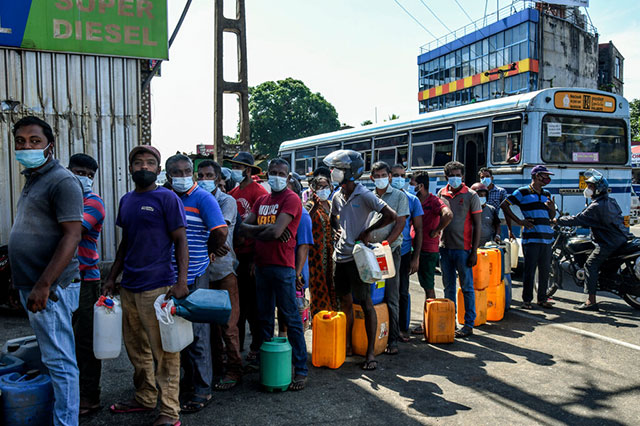
Lining up to buy diesel fuel in March. During one week, two men died while waiting in scorching heat.
(Photo: Atul Loke for The New York Times)
Following two years of a COVID-induced global slump, the world economy is now facing a “stagflation” crisis (stagnant growth plus runaway inflation), not seen on a global level since the 1970s. A widely predicted world recession will likely be compounded by a debt crisis hitting the entire world economy, but middle-income countries in particular. While Sri Lanka’s debt crisis has grabbed headlines due to the extreme shortages and explosive protests, Bloomberg Economics cites 19 countries facing imminent default on US$237 billion of outstanding debt – including Pakistan, Egypt, Argentina, Brazil, Tunisia, Kenya, South Africa and others – home to nearly a billion people.2 The IMF is tracking 73 highly indebted countries and estimates 40 of these are “high risk” or already in “debt distress,” double the number in 2015.
Sri Lanka is the first country to blow in the current crisis, but there will almost certainly be others, as dozens of countries are saddled with unpayable foreign debt. One of the first may be Argentina, where on 9 July – the same day that the Lankan masses stormed President’s House in Colombo – tens of thousands of workers marched in the streets of Buenos Aires calling to stop debt payments and to break with the IMF. In Sri Lanka, however, many in the desperate middle class are perversely looking to the international bankers’ cartel as a saviour, contrary to all history. Meanwhile, Egypt has US$7 billion due on external debt by February 2023, and Pakistan needs US$41 billion over the next 12 months for debt repayment and to fund imports. Already demonstrators have taken to the streets to protest power cuts of up to 14 hours to conserve fuel.
The Lankan economy suffers specific afflictions that sparked its debt crisis: looting by ruling families, depredations of the decades-long civil war, a dependency for hard currency on tourism and remittances from overseas workers (mostly from the oil-rich Arab/Persian Gulf sheikdoms), both of which collapsed during the COVID pandemic, and a reliance on food imports whose prices have shot up during the U.S./NATO-provoked war in Ukraine. Most of the recent protests focused on the symptoms (dynastic corruption, government malfeasance and cronyism), not the root causes of the crisis. To the extent that “progressives” looked for deeper causes, they pointed to “neoliberalism” and “financialisation” of the economy, i.e., policies, when in truth the origins of Sri Lanka’s economic collapse are in the system of imperialist capitalist exploitation.
Periodic debts crises are but one symptom of that exploitation. Under imperialism, the dominant financial institutions spread their tentacles over the entire planet. While the imperialist media want to blame the Lankan crisis on a “Chinese debt trap,” China holds only 20% of the country’s foreign debt while almost half (47%) is held by investment corporations (BlackRock), Wall Street banks (UBS, HSBC, JPMorgan Chase) and insurance giants (Allianz, Prudential).3 And in today’s unipolar world, U.S. imperialism calls the shots. So at the end of 2021, Lanka’s foreign debt ($50.6 billion) represented 60% of its annual gross domestic product ($84.5 billion), a percentage so high that bankers deemed it not creditworthy. Yet the U.S. external debt ($23.9 trillion) is 103% of its GDP ($23 trillion), and investors keep buying U.S. bonds
Seeking profits through imposing debt and loan repayments is one of the mechanisms of imperialist domination. Bourgeois regimes in lesser-developed countries usually have little alternative to these loans for investment purposes. And for the tiny minority on top, such loans are a lucrative source of self-enrichment through graft and kickbacks. When the economy goes south through a global slump or otherwise, the IMF steps in to “restructure” loans yet again and enforce repayments with inevitably onerous conditions for the masses. Nevertheless, virtually all the Lankan parliamentary opposition parties prior to Wickremesinghe’s appointment were united in calling for an all-party interim government (a call Wickremesinghe has now taken up) whose task would be to approve austerity measures being demanded by the IMF.
The measures required by the IMF will include slashing public service jobs, privatisation of essential services, attacks on public health and education, elimination of labour protections and withdrawal of subsidies on which millions depend for survival. The “opposition” which has called for an “all-party” government includes: the Samagi Jana Balawegaya (SJB), a party set up with the express approval of the UNP to divert public hostility from the government and take part in the 2020 elections; the Tamil National Alliance (TNA), representing the Tamil elite in the north; and the Janatha Vimukthi Peramuna (JVP – People’s Liberation Front), a Mao-Stalinist and Sinhala-chauvinist outfit which backed and even spearheaded the savage war against the LTTE and has supported bourgeois parties since the 1990s, even entering government in 2004.
The more “leftist” organisations in Lanka are not much better. The Frontline Socialist Party (FSP), a 2012 split from the JVP, initially called for a “consensus regime” of parliamentary parties and held talks to that end with the capitalist SJB and TNA and other smaller political parties including the United Socialist Party (USP). The results of such discussions could only be an attempt to bind the masses to yet another coalition committed to rescuing capitalism. Wary of being associated with the widely detested Wickremesinghe, the FSP and JVP have, at least for now, backed off this complete dead-end. The JVP is calling for “snap elections” while the FSP, sensing mass hostility to the parliamentary parties, has shifted to calling for “People’s Councils” (deliberately not councils of workers and toilers) as a basis for an alternative government. Both are bourgeois non-solutions to the crisis.
The USP, affiliated with Peter Taaffe’s Committee for a Workers International (CWI), characteristically calls for a “national assembly” to prepare the election of a “revolutionary constituent assembly”, the CWI’s often-invoked diversion from the tasks of social revolution. The problems besetting the “Democratic Socialist Republic of Sri Lanka” (the country’s official name, harking back to a time where “democratic socialism” was fashionable) will not be solved by having some bourgeois “democratic” assembly rewrite its oft-amended authoritarian constitution. To meet the desperate needs of the masses, what is required is an internationalist socialist revolution, driven by the urban and rural proletariat and linking up with the working people of India, Pakistan, Bangladesh and others in a socialist federation of South Asia.
Finally, the Socialist Equality Party (SEP) calls for “rank-and-file action committees” in factories and rural farming areas and, rather grandly, “convening of a Democratic and Socialist Congress of Workers and Rural Masses.” All to be done “independent of the trade unions.” The SEP is affiliated with David North’s WSWS internet operation, which three decades ago wrote off trade unions globally as mere instruments of capitalist rule. On the contrary, unions are defence organisations of the workers, riven by the contradiction between the working-class ranks and pro-capitalist bureaucracies at the top. While defending the unions against the bosses and their state, the task of genuine Marxists is to intervene in workers’ struggles to expose the treacherous misleaders in order to win the working-class masses to revolutionary politics.
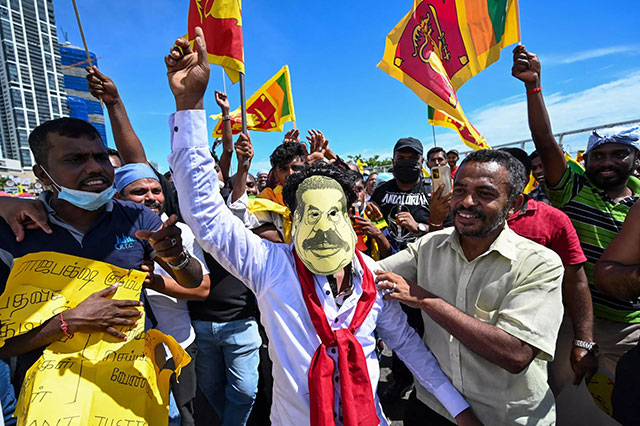
Millions joined one-day general strike on April 28, but trade-union leaders limited demands to ouster of President Gotabaya Rajapaksa (caricatured in mask) and Prime Minister Mahinda Rajapaksa. Revolutionaries would call for an all-out general strike with occupation of workplaces and the formation of workers defence guards. (Photo: Ishara Kodikara / AFP)
The WSWS strikes a phony “left” posture, but with its
anti-union line it actually lines up with the bosses,
earning it the sobriquet of “World Scab Web Site.” In Sri
Lanka, where the SEP has been around for some decades, one
can see how its fake-left policy is directly counterposed to
class struggle. Millions of Lankan workers participated in
two general strikes on 28 April and 6 May, the first in 40
years. Over 1,000 unions were involved in calling the
strikes, their leaders under enormous pressure from the mass
struggles erupting around them. The central demand of these
strikes remained limited by the union tops to calling for
the resignation of the Rajapaksa government, and plans for
an indefinite strike on 11 May were scuttled. Yet the
fact that these massive strikes were called and carried out
shows the inherently conflicted nature of the unions.
As the Lankan masses face ever more desperate conditions, with a wave of repression and intensified anti-working-class austerity, revolutionaries would call on the unions, the only mass organisations of the working class, to undertake an all-out general strike with occupation of workplaces and organisation of workers defence guards. Such bold action could serve as a platform to lead all of the workers and oppressed in a struggle for proletarian power, against all the capitalist parties and their state..
A Transitional Program Leading to Socialist Revolution
“There are decades where nothing happens; and there are weeks where decades happen.”
– V.I. Lenin
Revolutionary crises erupt in societies only at generally long intervals. These social upheavals frequently share two outstanding and essential characteristics: a belief by the masses that they can no longer go on in the old way and a loss of confidence – however fleeting – on the part of the ruling class in its continued ability to rule. But the social fever pitch that produces this acute confluence cannot last indefinitely. Either the revolution triumphs or the rulers regain their senses and find a way – through guile or the brute force of armed repression – to stabilise society on their terms.
Just weeks before Bolshevik-led Soviets seized state power in Russia, Lenin wrote a pamphlet titled The Impending Catastrophe and How to Combat It (September 1917). The striking relevance of the circumstances he describes – and the program he advances – with the current situation in Lanka bears quoting at some length.
“Unavoidable catastrophe is threatening Russia…. The railways will come to a standstill. The delivery of raw materials and coal to the factories will cease. The delivery of grain will cease…. The danger of a great catastrophe and of famine is imminent.
“Everybody says this. Everybody admits it.
“Yet nothing is being done.
“Control, supervision and accounting are the prime requisites for combating catastrophe and famine.… these measures are not being adopted only because, exclusively because, their realisation would affect the fabulous profits of a handful of landowners and capitalists.
“These principal measures [of control] are: (1) Amalgamation of all banks into a single bank, and state control over its operations, or nationalisation of the banks. (2) Nationalisation of the syndicates, i.e., the largest, monopolistic capitalist associations (sugar, oil, coal, iron and steel, and other syndicates). (3) Abolition of commercial secrecy. (4) Compulsory syndication (i.e., compulsory amalgamation into associations) of industrialists, merchants and employers generally). (5) Compulsory organisation of the population into consumers’ societies, or encouragement of such organisation, and the exercise of control over it.
“There is no way of effectively combating financial disorganisation and inevitable financial collapse except that of revolutionary rupture with the interests of capital and that of the organisation of really democratic control, i.e., control from ‘below,’ control by the workers and the poor peasants over the capitalists.
“Perish or forge full steam ahead. That is the alternative put by history.”
Add to these measures “Repudiate the debt!” (decreed by the Soviet government in February 1918) and you have the means of revolutionary control by the working class and its allies that forms a concrete platform of struggle for the Lankan masses today to: (a) combat the dissolution and destruction of society by bourgeois rule; (b) meet the immediate needs of the insurgent workers and their allies; and (c) point the way forward to socialist revolution.
Lenin’s method was codified in the early congresses of the Communist International and again in the 1938 Transitional Programme, written by his co-leader of the 1917 October Revolution, Leon Trotsky, which served as the founding document of the Fourth International. Trotsky observed that “The historical crisis of mankind is reduced to the crisis of the revolutionary leadership.” That crisis is excruciatingly evident in Sri Lanka today.
What existed in revolutionary Russia that is most absent in Sri Lanka is two-fold: a revolutionary party with the program and discipline to lead the revolution, and widespread councils of workers, soldiers and peasants (“soviets”) which were organs of class struggle that then formed the basis for a new government serving the revolutionary masses to come into existence.
We have cited various calls for different kinds of assemblies or councils put forward by left organisations in Sri Lanka today: “people’s councils” (FSP), “national assembly” to prepare a “revolutionary constituent assembly” (USP), all of which lack a working-class basis, and hence by default would assume a bourgeois character; while putative “rank-and-file action committees” to convene a “democratic and socialist congress of workers and rural masses” (SEP) have no link to existing organs of the working class. What these different formulas do not do is intervene in the actual struggle to raise transitional demands pointing to socialist revolution, which if taken up by the masses could give rise to the organisational forms that could become genuine soviets.
Cohering the nucleus of a revolutionary workers party, to be forged on the program of Lenin and Trotsky, is thus the essential task facing communists in Sri Lanka today. Inextricably linked to that is the internationalist perspective of revolution throughout the South Asian region. If the Stalinist nationalist dogma of “socialism in one country” was not possible in the vast, resource-rich lands of the former Russian empire, even less can it be successfully constructed if isolated in a small island nation with a population of 22 million and with natural resources accounting for less than 5% of exports. The only road forward for freeing the Lankan masses from debt servitude, mass poverty, racist terror and imperialist domination is the internationalist Trotskyist program of permanent revolution, the program of Red October 1917.
Forward to a Socialist Federation of South Asia!
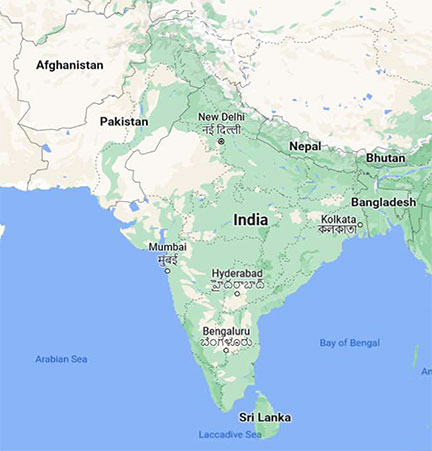 Map of South Asia. (Google Maps)
Map of South Asia. (Google Maps)Sri Lanka is not isolated. It has close ties to, and its political landscape is heavily influenced by, its much larger neighbours to the north. These include India (population 1.4 billion), Pakistan (221 million), and Bangladesh (165 million), as well as Nepal (30 million). Taken together, these countries have hundreds of millions of urban and rural proletarians, potential powerful allies in the struggle against capitalist immiseration. Further, India/Pakistan/Bangladesh together with Sri Lanka form an arc of extreme instability in an imperialist world whose masters rightly fear their control is fracturing.
In the fairy tale accounts in the imperialist press, prior to the collapse Sri Lanka was “one of the wealthiest countries in South Asia, ranked by the UN on a par with much of eastern Europe in terms of development” (Economist), an economic success story “soaring to the status of an upper-middle-income nation,” which “built a tourism-based economy that brought billions of dollars, many jobs and middle class comforts: high-end eateries and cafes, imported Jeeps and Audis, and upscale malls” (New York Times, 26 March). This may be the self-image of those who profited from the Rajapaksas’ rule, but it bore no relation to how the masses lived. Yes, Sri Lanka had higher income levels than its neighbours, but the garment workers and tea pickers producing for the world market lived no better than their counterparts elsewhere in the region.
Almost all of the nearly two billion people in South Asia live in conditions of imperialist-imposed privation and poverty. Average annual household expenditures per capita in these countries, in US dollars, are (CEIC data):
- Sri Lanka – $1,182
- Bangladesh – $592
- India – $574
- Pakistan – $525
In other words, on average the masses are living on less than 2 or at most 3 U.S. dollars a day per person. The comparable annual figure for Australia is US$27,595. And of course, averages conceal the huge disparities in income between the jet-setting elite and the extreme oppression of the overwhelming majority. In Lanka, the richest 10% hold a massive 63.8% of the island’s total wealth while the bottom 50% have just 4.3%.
Prior to European colonisation, there were advanced civilisations throughout the Indian subcontinent, as in China. But the needs of what Karl Marx called primitive capitalist accumulation led eventually to imperial enslavement being forced on the populations of these countries, as throughout the colonised world. The British empire directly controlled South Asia (encompassing what is now India, Pakistan, Bangladesh, Sri Lanka and smaller states) from the mid-19th century until after World War II. This was the richest prize of the Empire, its “jewel in the crown.” The British Raj (colonial administration) infamously mastered the use of “divide and rule,” fostering deadly sectarian, communal divisions. Hindu-Moslem tensions were inflamed, and the partition of India and Pakistan in 1947 resulted in mass population transfers of up to 15 million people and the deaths of between several hundred thousand and two million people.
Bangladesh was also an indirect product of British rule. East Bengal was partitioned off by the British in 1905, with a Muslim majority, and became part of Pakistan with the 1947 partition. In 1971, “East Pakistan” carried out an independence struggle, under the leadership of the bourgeois Awami League (with the support of the Indian army), and modern Bangladesh was created. Today, South Asia is a region of extreme exploitation, outrageous inequality and recurrent crises. The debt peonage that ensnares Lanka likewise extends throughout the subcontinent. External debt figures are $615 billion for India, $122 billion for Pakistan, $78 billion for Bangladesh, all exceeding Lanka’s $50 billion. This toxic debt burden exacerbates every aspect of the cruel exploitation gripping these nations, creating ever-deeper states of instability.
Every country in the region is wracked by religious and ethnic conflict, even as there is significant class struggle. India is currently ruled by Narendra Modi, leader of the Hindu-nationalist BJP (Indian People’s Party). Attacks by BJP gangs on Muslims, who are hacked, beaten or shot to death, further polarise the country. At the same time, in 2020-21 Indian farmers carried out a massive year-long “strike,” including blockages of the main roads to the nation’s capital. The protests successfully forced the government to scrap laws favouring agribusiness corporations. While not a working-class or even a peasant movement, the farmers’ action seriously undermined the government’s authority. Today, India’s capitalist economy is in the doldrums, with incomes falling and youth unemployment large and growing.
In Pakistan, the prime minister and former world-famous cricket star Imran Khan was forced out in April by a “no confidence” vote in parliament. This was widely seen as a slap down by Washington and Pakistan’s powerful military/intelligence establishment for Khan’s posturing against the West. In the same month that Russia invaded Ukraine, Khan made highly publicized trips for friendly discussions with both Russian president Vladimir Putin and Chinese president Xi Jinping. No Pakistani prime minister has ever served a full term and the position was unfilled during the years 1960–1973, 1977–1985, and 1999–2002 when the country was under military rule. Despite being a major recipient of US aid, Pakistan is high on the IMF’s list of countries most likely to default on their debt and Khan had applied for a new $6 billion IMF loan.
Meanwhile, in Bangladesh, in early August the government hiked petrol prices by 52%, in a move widely seen as a precursor to Lanka-like conditions. Thousands of protesters took to the streets in response. Already in July the Bangladesh government sought a $4.5 billion loan from the IMF, while also seeking $1 billion from the Asian Development Bank. Bangladesh is notorious for deadly working conditions among the horribly oppressed workers in the garment industry which accounts for more than 90% of export revenue. It is also beset by repeated waves of Islamist terror attacks against Hindus and other religious minorities (as well as secular writers, homosexuals and others deemed as infidels), often spurred by anti-Muslim attacks by Hindutva (Hindu nationalist) groups in India like the fascist RSS, closely allied with the governing BJP.
Thus the murderous communal terror by predominantly
Buddhist Sinhalese chauvinists against the predominantly
Hindu Tamils in Sri Lanka is mirrored throughout South Asia
– a direct result of the imperialist partition of the
subcontinent into separate and hostile ethnic and
religion-based states. This is epitomised by the continuing
division of Kashmir between India and Pakistan, and the
recent escalation of repression against the Muslim majority
population by the Indian army and police. The League for the
Fourth International has called to “Build Working-Class
Defense Guards to Fight Against Communalist/Fascist
Barbarism!” and for “self-determination for Kashmir and all
the oppressed peoples of the region.”4
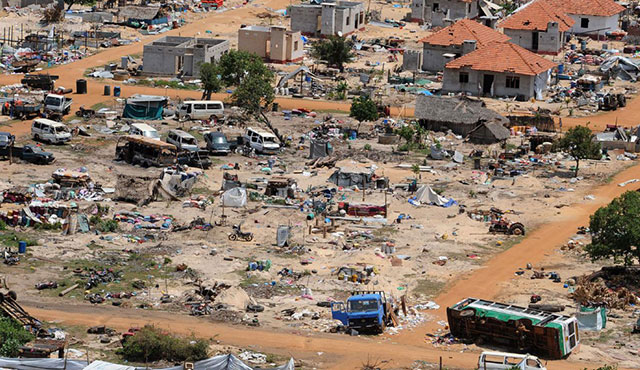
Aftermath of massacre of Tamils in Mullaitivu, a no-fire zone where civilians were gathered, in May 2009. Thousands were killed. Mahinda Rajapaksa was Lankan president, Gotabay Rajapaksa was head of the army. (Photo: Tamil Guardian)
In Sri Lanka, the League for the Fourth International calls today – as we did in the International Communist League, when it stood on the internationalist program of revolutionary Trotskyism – for workers defence of the endangered Tamil and Muslim minority populations against Sinhalese chauvinist attacks, and for the right of Tamil self-determination, as part of the struggle for a socialist federation of South Asia. The subcontinent will not escape the fate that international capital is dealing to Sri Lanka. And the working people of Lanka will find the power to combat their own corrupt and thieving ruling class only in unity with their sisters and brothers to the north. Overcoming the imperialist division of the subcontinent through united class struggle of the oppressed and downtrodden under proletarian leadership would be an inspiration for the workers of the world.
Looking to the IMF and other imperialist agencies, seeking unity with the parties of the bourgeoisie, spell doom for the working people. As Wickremesinghe calls on the troops to suppress protest, as the Rajapaksas await their U.S. “green cards” and pseudo-socialists seek coalition governments to rescue capitalist rule on the island, the central task of revolutionaries is to build Leninist-Trotskyist parties of the proletarian vanguard, to lead all the oppressed in socialist revolution against imperialism and its boundlessly avaricious local viceroys. ■
- 1. After early retirement from the army, Gotabaya Rapaksa worked in information technology in the U.S. from 1998 to 2005. His wife is a U.S. citizen.
- 2. “Historic Cascade of Defaults Is Coming for Emerging Markets,” Bloomberg, 7 July.
- 3. “‘The Canary in the Coal Mine’: Sri Lanka’s Crisis is a Chronicle Foretold,” Committee for the Abolition of Illegitimate Debt (CADTM), 7 August.
- 4. “India-Pakistan: For Workers Revolution Against the Chauvinist Warmongers!” The Internationalist No. 13, May-June 2002.
